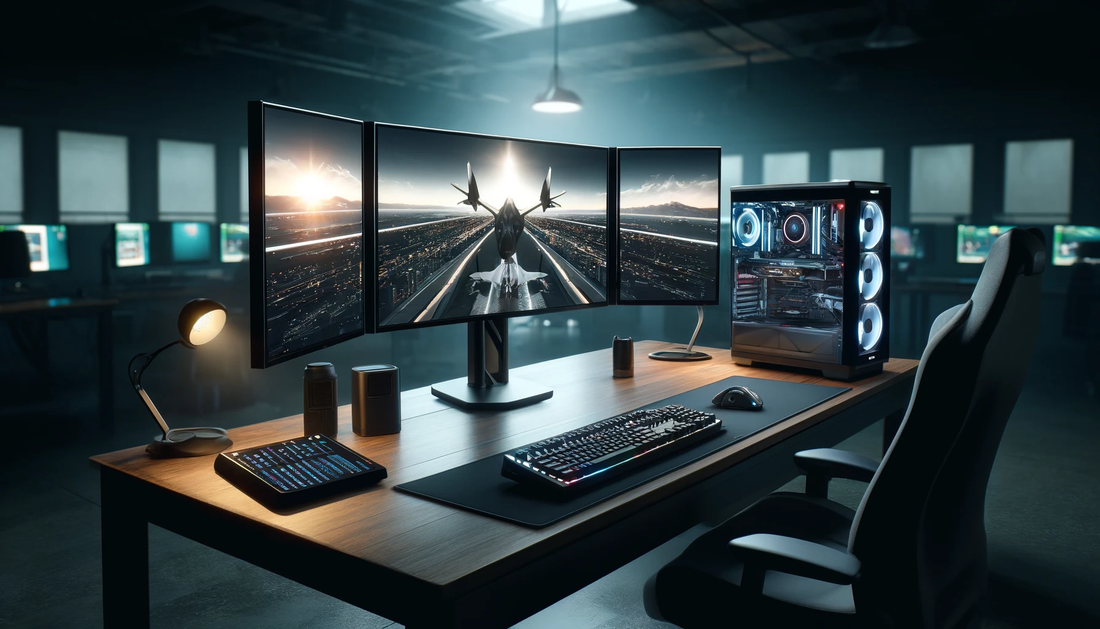
From Single Monitors to Full Cockpit Displays: The Best Multi-Screen Setups
Share
The rapid advancements in display technology have transformed the way users interact with digital content. Whether for professional workstations, gaming, or flight simulation, multi-screen setups have become essential for maximizing efficiency, immersion, and productivity. While single monitors served as the standard for many years, the shift towards multi-screen configurations has significantly improved workflow, multitasking capabilities, and gaming experiences.
Users are no longer restricted to a single display; they now have access to expansive setups that enhance productivity and realism. From dual-monitor configurations to full cockpit displays, choosing the right multi-screen setup can greatly impact one’s work or gaming experience.
This article explores the best multi-screen setups, their benefits, and essential considerations to ensure an optimal display arrangement.
Choosing the Right Multi-Screen Setup
Selecting the best multi-screen setup depends on the intended purpose. Some users require multiple monitors for work, while others seek immersive gaming or simulation experiences. Understanding the available configurations and their advantages is crucial when designing the perfect setup.
Dual-Monitor Setups for Enhanced Productivity
A dual-monitor setup is the most common configuration for professionals and casual users looking to improve multitasking. It offers a seamless way to work on multiple applications simultaneously without excessive switching between tabs.
Benefits of a Dual-Monitor Setup
- Improved workflow efficiency: Writers, programmers, and designers benefit from viewing reference materials while working on their primary screen.
- Better organization: Emails, spreadsheets, and video conferencing applications can be displayed on separate screens for easy access.
- Gaming and streaming support: Gamers often use a second screen for live streaming, communication, or monitoring in-game stats.
- Cost-effective upgrade: Compared to advanced multi-screen configurations, a dual-monitor setup is an affordable way to boost productivity.
Triple-Monitor Setups for an Immersive Experience
A triple-monitor setup is ideal for users who require more screen space for detailed tasks, gaming, or simulations. It creates a panoramic view, reducing the need to constantly switch between windows.
Advantages of a Triple-Monitor Setup
- Perfect for gaming and simulations: Racing and flight simulators significantly benefit from a wide field of view.
- Expanded workspace: Video editors, architects, and engineers can utilize three screens for editing, designing, and rendering.
- Increased trading efficiency: Stock market traders monitor multiple data sources simultaneously with ease.
- Seamless multitasking: Users can dedicate each screen to a specific function, improving productivity and workflow.
Ultra-Wide Monitors vs. Multi-Screen Setups
Some users opt for ultra-wide monitors instead of multiple displays. While ultra-wide screens offer a seamless experience without bezels, they may not provide the flexibility of multi-monitor setups.
Pros and Cons of Ultra-Wide Monitors
-
Advantages:
- No bezels between screens for a fluid display.
- High resolutions with advanced refresh rates.
- Ideal for gaming and content creation.
-
Limitations:
- Limited positioning flexibility.
- Expensive compared to multiple standard monitors.
- Some software compatibility issues may arise.
Full Cockpit Display Setups for Flight Simulation
For aviation enthusiasts, a full cockpit display provides the most realistic experience. A g1000 simulator setup closely replicates real aircraft avionics, offering an advanced level of realism. Multiple monitors and additional hardware create a true-to-life flying experience.
Key Features of a Full Cockpit Display Setup
- Highly immersive environment: Multiple screens simulate the cockpit view accurately.
- Realistic instrument panels: Flight instruments, navigation displays, and control panels replicate an actual aircraft.
- Seamless integration with hardware: Joysticks, throttles, and rudder pedals enhance control precision.
- Professional training applications: Pilots use these setups for practice and familiarization with various aircraft systems.
Essential Considerations for Multi-Screen Setups
Before setting up a multi-screen configuration, several factors must be considered to ensure optimal performance and user comfort.
Graphics Card Performance
Running multiple monitors requires a powerful graphics card to support high resolutions and refresh rates. Choosing the right GPU is critical for a smooth experience.
- Gaming and simulation needs: High-end GPUs prevent lag and screen tearing.
- Workstation-class GPUs: Designers and video editors benefit from professional-grade graphics cards.
- Compatibility: Ensure the graphics card has enough ports and processing power for multiple screens.
Ergonomics and Monitor Placement
Proper positioning of monitors reduces eye strain and enhances productivity. Adjustable mounts and stands help achieve ergonomic efficiency.
- Monitor arms and stands: Enable precise height and angle adjustments.
- Curved screens for an enhanced field of view: Reduce distortion and glare while increasing immersion.
- Proper desk arrangement: Adequate spacing prevents clutter and enhances workflow.
Software Optimization for Multi-Screen Setups
To make the most of a flight simulator setup or a multi-monitor workstation, software optimization is essential.
- Display settings configuration: Adjusting resolutions, refresh rates, and alignment for seamless performance.
- Multi-monitor management software: Applications like DisplayFusion and NVIDIA Surround help manage displays efficiently.
- Application window snapping: Enhances multitasking by organizing open windows across multiple screens.
The Future of Multi-Screen Setups
Display technology continues to evolve, bringing even more advanced multi-screen setups. Innovations such as OLED monitors, 8K displays, and curved ultra-wide screens offer improved resolutions and refresh rates. As new display solutions emerge, users will have even more options to enhance their workstations and gaming experiences.
- Higher refresh rates: Ideal for competitive gaming and real-time simulations.
- Better color accuracy: Essential for designers and content creators.
- More flexible screen arrangements: Foldable and modular displays provide new possibilities for multi-screen setups.
The transition from single monitors to full cockpit displays has revolutionized digital experiences across various fields. Whether using a flight simulator setup for aviation training, a triple-monitor configuration for gaming, or a dual-screen workstation for professional tasks, the right setup significantly improves efficiency and immersion. By selecting the appropriate hardware, ensuring ergonomic placement, and optimizing software, users can create an engaging and efficient multi-screen environment.
Investing in a well-structured multi-screen setup is not just about having more displays—it is about maximizing productivity, enhancing realism, and achieving a seamless digital experience. As technology advances, multi-screen configurations will continue to shape how people work, play, and interact with digital content.
